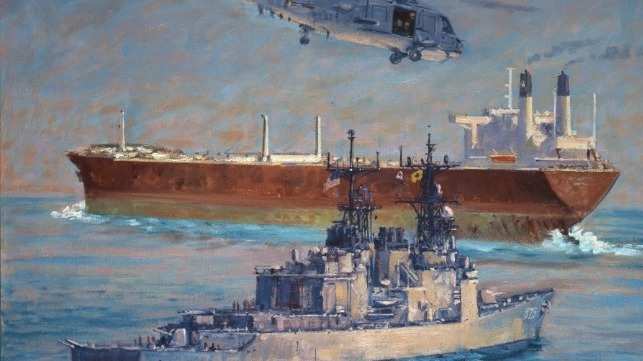Remembering the 30th Anniversary of Operation Desert Storm

The guided missile frigate Reid fired the first shot of Desert Shield/Desert Storm on 18 August 1990 and, later the same day, it was followed by USS Robert G. Bradley. In separate incidents, both ships fired across the bows of Iraqi tankers leaving the Arabian Gulf, the first attempted enforcement actions of United Nations Security Council Resolution 661 (passed 16 August), which declared an embargo on Iraqi oil (and stolen Kuwaiti oil) from leaving Iraq and prohibited goods from entering. The tankers called our bluff and kept going as the actual use of force to enforce the embargo was not authorized by the UNSC until 26 August. Nevertheless, also on 18 August, England and Scott diverted ships in the Red Sea and North Arabian Gulf, the first diversions of Operation Desert Shield. By the beginning of September, U.S. Navy enforcement of the UN sanctions was well underway, averaging 40 intercepts and four boardings per day—1,000 intercepts by 16 September.
On 19 August, the Commander of the U.S. Seventh Fleet, Vice Admiral Henry H. Mauz, was designated as the Commander, U.S. Naval Forces Central Command after flying in to Bahrain. By the time the Seventh Fleet flagship, Blue Ridge, arrived in Bahrain on 1 September, three U.S. aircraft carriers and a battleship were already on station in the Central Command area of operations (AOR), ready to counter any further Iraqi aggression. Following the Iraqi invasion of Kuwait on 2 August, the carrier Dwight D. Eisenhower transited the Suez on 7 August, the same day that Independence arrived in the Gulf of Oman (U.S. Air Force F-16s first arrived in Saudi Arabia on 10 August). Battleship Wisconsin (BB-64) transited the Suez on 17 August and entered into the Arabian Gulf on 24 August. Saratoga (CV-60) came through the Suez on 22 August. A fourth carrier, John F. Kennedy (CV-67), arrived in the Red Sea on 14 September.
The first fast sealift ships arrived on 27 August. As there were no established U.S. bases in Saudi Arabia, without sealift the Air Force and Army would have run out of bombs and ammunition in short order had the war commenced at that point.
The hospital ship Comfort arrived 7 September and Mercy by 23 September. Between 4 and 11 September, 20 Atlantic and Pacific Fleet amphibious ships arrived in the CENTCOM AOR and, by 16 September, all were in the Gulf of Oman, carrying the 4th Marine Expeditionary Brigade, the 13th Marine Expeditionary Unit, and 1st Battalion, 6th Marine Regiment.
On 31 August, the cruiser USS Biddle conducted the first boarding under UNSCR 661; the empty ship was allowed to proceed into Aqaba, Jordan. On 4 September, the destroyer Goldsborough intercepted and boarded the Iraqi cargo ship Zanoobia, which was found to be carrying prohibited cargo and was diverted, the first diversion of an Iraqi-flag ship. On 27 September, the frigate Elmer Montgomery had to fire warning shots to get the Iraqi tanker Tadmur to stop for boarding.
Rear Adm. Sam Cox (USN, ret'd.) is the director of Naval History and Heritage Command. He is responsible for the Navy's museums, art and artifact collections, the research library, 150 million pages of archives, and for collecting and interpreting U.S. Naval history throughout the world. In his 37-year naval career, Cox served as an intelligence officer, retiring in November 2013, as the senior naval intelligence community leader and from both command of the Office of Naval Intelligence and as director of the National Maritime Intelligence-Integration Office. He also previously served as director of Intelligence (J2), U.S. Cyber Command.
The opinions expressed herein are the author's and not necessarily those of The Maritime Executive.

